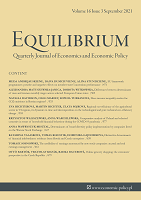EU framework programmes: positive and negative effects on member states' innovation performance
EU framework programmes: positive and negative effects on member states' innovation performance
Author(s): Meda Andrijauskiene, Daiva Dumčiuvienė, Alina StundžienėSubject(s): Economic policy, EU-Approach / EU-Accession / EU-Development
Published by: Instytut Badań Gospodarczych
Keywords: innovation performance; national innovative capacity; EU investment;
Summary/Abstract: Research background: Seeking to ensure competitiveness in the global market, the EU is constantly improving its innovation policy. Compared to other EU initiatives, the Framework Programs for Research and Innovation (FPs) act as the main instrument with the longest history and the largest budget to boost member states' innovation performance. Despite the initial presumptions that these financial inflows should bring positive and constructive effects, the results significantly diverge across the countries with highly uneven and incoherent progress. Therefore, complex and reliable tools must be adopted to evaluate the long-term influence of EU investment and the reasons which distort the innovation performance in separate member states. Purpose of the article: The purpose of this article is to evaluate the influence of EU investment on its member states? innovation performance by using a redeveloped national innovative capacity framework and including technological, non-technological and commercial innovative output. Methods: Panel unit root tests were used to assess the time series stationarity. Autoregressive distributed lag models helped in calculating the long-term influence of EU investment on member states? innovation performance. Finally, by employing dummies, it was analysed how this influence varied over time and across different countries. Findings & value added: The findings provide evidence that EU investment exerts positive long-term influence on the technological innovative output proxied as total, business and higher education institutions? patent applications, as well as product and process innovations. The effects were also positive on trademarks and marketing, and organisational innovations. However, small but negative influence was found in the case of patent applications by the government sector and the exports of hi-tech products and knowledge-intensive services. These insights may serve in the designing process of the specific instruments and the future innovation policies, which would bring the maximum benefit for the society and economy.
Journal: Equilibrium. Quarterly Journal of Economics and Economic Policy
- Issue Year: 16/2021
- Issue No: 3
- Page Range: 471-502
- Page Count: 32
- Language: English

